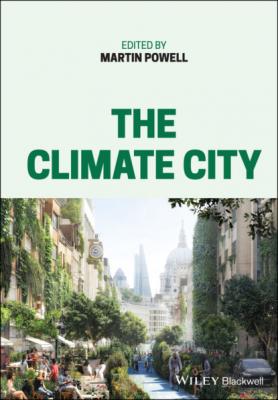The Climate City. Группа авторов
Читать онлайн.| Название | The Climate City |
|---|---|
| Автор произведения | Группа авторов |
| Жанр | Техническая литература |
| Серия | |
| Издательство | Техническая литература |
| Год выпуска | 0 |
| isbn | 9781119746317 |
12 12 US Global Change Research Program, 2018. Fourth National Climate Assessment. Vol. II. https://nca2018.globalchange.gov/downloads.
13 13 Ripple, W.J., Wolf, C., Newsome, T.M., Barnard, P., Moomaw, W.R., 2020. World scientists’ warning of a climate emergency. BioScience 70(1) January, 8–12. https://academic.oup.com/bioscience/advance-article/doi/10.1093/biosci/biz088/5610806.
14 14 C40: Deadline 2020. https://www.c40.org.
15 15 UNFCCC, 2021. Who’s in Race to Zero? https://unfccc.int/climate-action/race-to-zero/who-s-in-race-to-zero#eq-4.
16 16 C40: Consumption-Based GHG Emissions of C40 cities. https://www.c40.org/researches/consumption-based-emissions.
17 17 US EPA, n.d. Greenhouse gases at EPA. https://www.epa.gov/greeningepa/greenhouse-gases-epa (accessed 3 June 2020).
18 18 C40. Op. cit., p. 15.
19 19 Greenhouse gases are “any gas that has the property of absorbing infrared radiation (net heat energy) emitted from Earth’s surface and reradiating it back to Earth’s surface, thus contributing to the greenhouse effect. Carbon dioxide, methane and water vapor are the most important greenhouse gases. (To a lesser extent, surface-level ozone, nitrous oxides, and fluorinated gases also trap infrared radiation.)” Encyclopaedia Britannica, n.d. Greenhouse gas. https://www.britannica.com/science/greenhouse-gas (accessed 3 June 2020).
20 20 McKinsey Quarterly, 2020. Climate math: What a 1.5-degree pathway would take. https://www.mckinsey.com/business-functions/sustainability/our-insights/climate-math-what-a-1-point-5-degree-pathway-would-take.
21 21 Science Based Targets, n.d. What are “science based targets”? https://sciencebasedtargets.org/what-is-a-science-based-target (accessed 3 June 2020).
22 22 City Finance Approach to Climate-Stabilising Targets, 2018. https://www.autodesk.co.uk/sustainability/business-operations/cfact-cities.
23 23 https://resourcecentre.c40.org/climate-action-planning-framework-home.
24 24 https://www.london.gov.uk/sites/default/files/1.5_action_plan_amended.pdf.
25 25 Disclosure – The author is a Senior Advisor to, and supporter of, REDD.plus.
26 26 McKinsey Quarterly, 2020. Op. cit., pp. 9–11.
27 27 Microsoft, 2020. Microsoft will be carbon negative by 2030. https://blogs.microsoft.com/blog/2020/01/16/microsoft-will-be-carbon-negative-by-2030 (accessed 3 June 2020).
28 28 Sourcing analysis for scalability of abatement solutions (McKinsey Global Institute, Global Carbon Budget 2015, Coalition for Rainforest Nations). The top three sectoral abatement opportunities are Forests & Agriculture (estimated 10–12 Gt pa). Power at 10 Gt pa and Industry at 8 Gt pa.
29 29 Sustainability – Operation Cat Drop. https://www.youtube.com/watch?v=17BP9n6g1F0v=.
30 30 Argyris, C., 1990. Overcoming Organizational Defenses: Facilitating Organizational Learning. Pearson, New York.
31 31 https://waterscenterst.org.
32 32 Meadows, D., 1999. Leverage Points: Places to Intervene in a System. Sustainability Institute, Hartland, VT.
2 The Civilized City – Introduction
Peter’s conclusion in Chapter 1 was for connected leadership within the modern city. In Chapter 2 I am going to take us into the past to get a stronger sense of why we need to be “systems thinkers” and how we can deliver Peter’s clarity and ambition in today’s city.
Cities themselves are stories. They are not constructed with pen and paper but are built with bricks and mortar. The one thing that remains constant, however, is the human imagination behind them, but just like the way we tell stories changes over time, the way we build and design cities must also change. In Chapter 1, The Ambitious City, Peter discusses how city leadership can aim “beyond” its goals; I too look at some of the ways that cities can move beyond their historical infrastructure to rise up and meet the environmental challenges that face the modern city, and, most importantly, how we can apply those learnings for a better future.
I look at the lessons learnt through the history of cities, from Uruk, the world’s first city (Figure 2.1), to Silicon Valley. I explore what we have learnt to do and not do, along with the history of innovation, problem solving, and governance, and discover qualities that prove to us cities are going to solve the climate crisis, making the case for why local governments are more capable than national governments of addressing this challenge.
Figure 2.1 Uruk. (Source: SAC Andy Holmes / Wikimedia Commons / Public Domain.)
Many cities are increasing in size and power, leading to environmental degradation, social dis-cohesion, and cultural barbarism. This may seem to predict a dire outcome, but we must remember that the city, as a product of human design, attracts innovative people, absorbing them into its bloodstream, who proceed to invent, inspire, and attract other innovators who synthesize art and technology and move society forwards. From the cultural advancements of Athens and Florence, to the cotton mills of Manchester and the Industrial Revolution, and, most recently, the technological innovations of Silicon Valley (Figure 2.2), human invention has made all the difference in urban development.
Figure 2.2 The “Spaceship” Campus, called the ring in Cupertino, California. (Source: Dronandy/Getty Images)
The question is which story do we tell next, and, more importantly, how? As the great American writer Mark Twain said, “there is no such thing as a new idea”, just as there is no reason as to why modern cities shouldn’t benefit from lessons learnt
